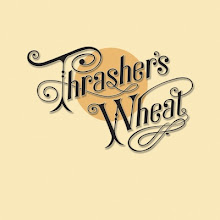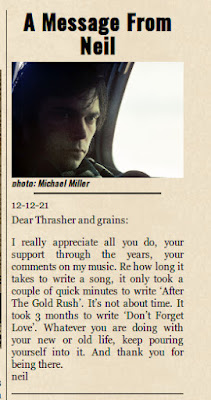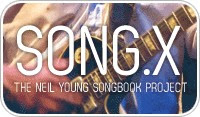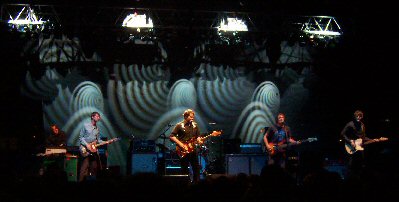A Few Thoughts on Album Early Daze by Neil Young and Crazy Horse
Here are a few thoughts on Early Daze by Neil Young and Crazy Horse by Scotzman.
“There’s no real murder in it.”
That’s what Neil Young once said about Down By The River, in its early daze.
Oh, many versions since—including, for example, the lunatic version from Dallas 1989—are vicious enough to make us question whether the narrator of the song has a body stashed underneath his bedroom floorboards.
But that’s in the future. Listening to the newly-released edit of the original 1969 studio version of Down By The River (the same band performance, but with an early lead-vocal overdub and different backing vocals), there’s not only no murder, there’s no suspicion of murder, either.
It’s sensitively performed. But Lieutenant Columbo stays home with his wife.
1969 feels like a different era… a very different era. Bassist Billy Talbot and drummer Ralph Molina are 25 years old. Neil Young is still 23, and is decades away from writing Cocaine Eyes, Eldorado or Rockin’ In The Free World.
Even Like A Hurricane doesn’t exist! Neither do the big Rust-era “amplifiers”.
Mirrorball hasn’t been recorded yet; the members of Pearl Jam are only about 3 years old.
For those of us either not yet born or still very young in 1969, it’s a time we don’t remember, but instead *imagine*. We see it on a movie screen in our minds. Palm trees, bright sun, classic American cars, a slightly gritty and grainy picture. The music on Early Daze is the soundtrack.
In 1969, Neil is still finding his range as a performing artist. He’s still discovering he can play different characters, each representing a different part of his psyche.
But more than that, there’s a through-and-through innocence to the sound of these recordings. Jangly and bright and care-free. Slipping down as easy as honey liqueur, with a touch of edge as the alcohol hits.
A rolling start.
Before super-fame. Before the fed-into-the-waste-disposal-machine grind of the Time Fades Away tour.
Back when Danny Whitten was still alive.
Consider: If we were to make a two-part movie about Neil Young’s career (working title: “Before and After”), where would we put the dividing line… the gap between before and after?
One temptation, I think, would be to start ‘part two’ in 1996: just after Neil’s producer David Briggs died.
But of course, Briggs’s immense influence on Neil’s music has carried on beyond his death. That’s why a recording like, say, Walk Like A Giant has such spiritual guts to it. Because others—not least guitarist Poncho Sampedro—have carried the torch and kept the spirit alive.
Instead, perhaps, the second film should begin with the aftermath of Danny Whitten’s death in 1972.
Because that’s when everything changes. That’s when the sun goes in, and when the chilled and relentless rain falls into greasy urban puddles.
Listen to Winterlong on Early Daze… then listen to the agonized (and perhaps artistically superior) version on Decade — recorded after Danny’s death.
Listen to Heart of Gold on Harvest… then listen to the grating, tone-deaf din of Tuscaloosa.
Listen to the newly-released Down By The River, innocent at heart…. then watch the thrilling slasher version from Concord 1993.
Listen to Come On Baby Let’s Go Downtown… then listen to Mellow My Mind.
Listen to Leave the Driving (a story of drug-related death/murder) and Carmichael (a story of the ensuing grief).
It’s not just the “ditch” period. It’s everything since Danny died. The music—metaphorically, at least—is haunted.
In the early seventies, Danny Whitten was a very sick man. He needed help, and he didn’t get it. That’s the tragedy. It’s no wonder the next few years of Neil Young music are so bleak, so tortured.
Drummer Ralph Molina said “we should’ve been able to do more for Danny”. And on one level, maybe he’s right.
But of course, it’s near-impossible for any one person to know *how* to help. How, exactly, do you help a man addicted to heroin? It’s not a question most of us—self included—are trained how to answer.
It’s a bit like the question “how do you help a family member who is clinically depressed”?
Everybody wants to help… nobody (other than a trained specialist) knows how. The end result is that nothing gets done, with no malicious intent whatsoever.
I know Neil has blamed himself, so has Ralph, so have Danny’s other friends. That’s because they are good people who care. Not because they’re actually to blame.
It’s one of those situations where we wish we could change the past, but can’t. Nobody intended for Danny to die, but that didn’t stop it happening.
In 1973, “all that glitters is not gold”. “Everything’s cheaper than it looks”. Neil Young has found fame, but the trappings of fame have made him unhappy. And along with his bandmates, he feels a great deal of guilt about Danny’s death. Tequila and art take the place of therapy sessions, and one way or another, the survivors find a way through.
Here’s Neil himself, speaking to biographer Jimmy McDonough about the end of the early daze of Crazy Horse:
“We knew what we had. We all knew it was really good. Then to see it get f**ked up was really depressing. Seeing drugs come in and f**k it up, seeing the whole thing just go downhill. The inexperience of not knowing how to deal with heroin use, not knowing what it was, being too young for certain kinds of decisions. But that was the hand I was dealt at the time. The destruction of Danny’s life…”.
The Early Daze album, meanwhile, comes before. Bright and relaxed; chilled out, with an effortless rock ‘n’ roll edge. Neil records with his show-biz buddies CSN—his day job, of sorts—and then has fun playing with Crazy Horse in his spare time.
The in-studio banter is relaxed and charming and inviting; the music, too. It’s a record that documents a band enjoying the journey of making art for its own sake. With David Briggs in the control room: the ringleader, the motivator. Another unseen and much-missed member of Crazy Horse.
And with Danny Whitten still alive, still healthy, sharing the spotlight, playing and singing beautifully, for us all to hear and enjoy.
-Scotsman.
Labels: @CrazyHorse4HoF, album, crazy horse, neil young, Neil Young and Crazy Horse, review
































 Human Highway
Human Highway

















 Concert Review of the Moment
Concert Review of the Moment





 This Land is My Land
This Land is My Land

 FREEDOM In A New Year
FREEDOM In A New Year









 *Thanks Neil!*
*Thanks Neil!*




![[EFC Blue Ribbon - Free Speech Online]](http://www.thrasherswheat.org/gifs/free-speech.gif)











 The Unbearable Lightness of Being Neil Young
The Unbearable Lightness of Being Neil Young Pardon My Heart
Pardon My Heart



 "We're The Ones
"We're The Ones  Thanks for Supporting Thrasher's Wheat!
Thanks for Supporting Thrasher's Wheat!




 This blog
This blog 
 (... he didn't kill himself either...)
#AaronDidntKillHimself
(... he didn't kill himself either...)
#AaronDidntKillHimself









































































 Neil Young's Moon Songs
Neil Young's Moon Songs




 Civic Duty Is Not Terrorism
Civic Duty Is Not Terrorism Orwell (and Grandpa) Was Right
Orwell (and Grandpa) Was Right


 What's So Funny About
What's So Funny About 


